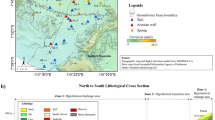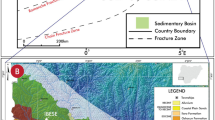Abstract
The geochemical evolution of groundwater in the coastal area of the Thriassion Plain, Attica, Greece, has been investigated using major and trace elements of chemical analyses. The groundwater of good quality (total dissolved solids TDS between 400 and 1100 mg/l) has been found in the Plio-Pleistocene sediments up to the depth of 90 m below sea level. Moreover, the existing contamination of groundwater in the Pleistocene-Holocene sediments possibly originates from the pumping of the old brackish water of the upper aquifers and the returns of the irrigation water as well as the possible occurrence of palaeo-seawater in the aquifers. A five-stage conceptual model is suggested for groundwater geochemical evolution from the main recharge area to the main discharge area. Limestone and dolomite dissolution in the recharge area leads to one end member of the Ca-Mg-HCO3 type. These waters evolve to Ca-Mg-Cl-HCO3 along their flow path possibly due to the dissolution of relics of evaporites, as well as mixing with seawater that is Na-Cl type, the other end member. Two more hydrogeochemical processes have also been identified; possibly gypsum, anhydrite, halite and fluorite dissolution; calcite, aragonite and dolomite precipitation.









Similar content being viewed by others
References
Alam, S.M.M. (2010). Hydrogeochemical evolution of groundwater of part of Ganges-Meghna Deltaic Plain AQUA mundi Am03029: 071 – 082.
Alcala, F., & Custodio, E. (2008). Using the Cl/Br ratio as a tracer to identify the origin of salinity in aquifers in Spain and Portugal. Journal of Hydrology, 359(1), 189–207.
Alloway, B. J. (1995). Heavy metals in soils (2nd ed.p. 368). London: Blackie Academic & Professional.
Andreasen, D., & Fleck, W. (1997). Use of bromide: Chloride ratios to differentiate potential sources of chloride in a shallow unconfined aquifer affected by brackish-water intrusion. Hydrogeology Journal, 5(2), 17–26.
Appelo, C. A. J., & Postma, D. (1993). Geochemistry, groundwater and pollution (p. 536). Rotterdam: Balkema.
Back, W., & Hanshaw, B. B. (1970). Comparison of chemical hydrogeology of the carbonate peninsula of Florida and Yucatan. Journal of Hydrology, 10(4), 330–368.
Burdon, DJ., & Mazloum, S. (1958). Some chemical types of groundwater from Syria. UNESCO Symp., Teheran, pp 73-90, UNESCO, Paris.
Cardenal, J., Benavente, J., & Cruz-Sanjulian, J. J. (1994). Chemical evolution of groundwater in Triassic gypsum-bearing carbonate aquifers (Las Alpujarras, southern Spain). Journal of Hydrology, 161(1-4), 3–30.
Chan, L. H., Gieskes, J. M., You, C. F., & Edmond, J. M. (1994). Lithium isotope geochemistry of sediments and hydrothermal fluids of the Guaymas Basin, Gulf of California. Geochimica et Cosmochimica Acta, 58, 4443–4445.
Christides, A., Mavrakis, A., Mitilineou, A. (2011). A case of intense seawater intrusion to aquifer of the Thriasio Plain, Greece. Proceedings of the 12th International Conference on Environmental Science and Technology (12th ICEST). Vol B: 152-159.
Davis, S. N., Whittemore, D. O., & Fabryka-Martin, J. (1998). Uses of chloride/bromide ratios in studies of potable water. Ground Water, 36(2), 338–350.
Deligiannakis, G., Papanikolaou, I. D., & Roberts, G. (2018). Fault specific GIS based seismic hazard maps for the Attica Region, Greece. Geomorphology, 306, 264–282. https://doi.org/10.1016/j.geomorph.2016.12.005.
Dounas, Α., & Panagiotides, G. (1964). Precursor report on the hydrogeological conditions of Thriassion Institute of Geology and Subsurface Research, Athens.
Edmunds, W. M., & Smedley, P. L. (2013). Fluoride in Natural Waters. In Fluoride in natural waters In: Selinus O (Ed) Essentials of medical geology, Springer, Netherlands, pp 311–336.
Fetter, C.W. (2001). Contaminant hydrogeology. Prentice Hall, 500 pp
Freeze, R. A., & Cherry, J. A. (1979). Groundwater (604 pp). Englewood Cliffs, NJ: Prentice-Hall Inc..
Gurunadha Rao, V. V. S., Tamma Rao, G., Surinaidu, L., Mahesh, J., Mallikharjuna Rao, S. T., & Mangaraja Rao, B. (2013). Assessment of geochemical processes occurring in groundwaters in the coastal alluvial aquifer. Environmental Monitoring and Assessment, 185(10), 8259–8272. https://doi.org/10.1007/s10661-013-3171-x.
Hanshaw, B., & Back, W. (1985). Deciphering hydrological systems by means of geochemical processes. Hydrological Sciences Journal, 30(2), 257–271. https://doi.org/10.1080/02626668509490988.
Hem, J.D. (1985). Study and interpretation of the chemical characteristics of natural waters, 3rd edn. U.S. Geological Survey Water-Supply Paper 2254.
Heathcote, J. A., & Lloyd, J. W. (1984). Groundwater chemistry in Southeast Suffolk (UK) and its relation to quaternary geology. Journal Hydrology, 75, 143–165.
Hermides, D. (2018). Hydrogeological conditions of the Thriassion Plain basin with emphasis on the geohydraulic characteristics of the aquifers and the groundwater quality. PhD thesis, Agricultural University of Athens, pp 283.
Hermides, D., & Stamatis, G. (2017). Origin of halogens and their use as environmental tracers in aquifers of Thriassion Plain, Attica. Greece Environmental Earth Science, 76(8), 306. https://doi.org/10.1007/s12665-017-6611-z.
Hermides, D., Mimides, T., & Stamatis, G. (2016). Contribution to hydraulic characteristics of Plio-Pleistocene deposits of Thriassion Plain of Attica. Bulletin of the Geological Society of Greece, 50(2), 967–976. https://doi.org/10.12681/bgsg.11801.
Iliopoulos V., Stournaras G., Stamatis G. (2011). Marine and human activity effects on the groundwater quality of Thriassio Plain, Attica, Greece. 9th Intern. Hydrogeological Congress of Greece, Kalavrita, 5-8 October 2011, N. Lambrakis et al. (Eds.), Advances in the research of aquatic environment, Vol. 2:409-416, https://doi.org/10.1007/978-3-642-24076-8, © Springer-Verlag Berlin Heidelberg 2011.
Jalali, M. (2007). Hydrochemical identification of groundwater resources and their changes under the impacts of human activity in the Chah Basin in Western Iran. Environmental Monitoring and Assessment, 130, 347. https://doi.org/10.1007/s10661-006-9402-7.
Kallieris, D. (2010.) Our village, volume 2nd, Cultural Center M. of Aspropyrgos, pp 586.
Karambela, A., (1997). Geomorphological and environmental study of Thriassion Plain PhD, Faculty of Geology and Geoenvironment, NKUA pp 289.
Katsikatsos, G., Mettos, A., Vidakis, M., Dounas, A., Pomoni, F., Tsaila-Monopolis, S., Skourtsi-Koroneou, V. (1986). Geological map of Greece, in scale 1:50.000. “Athina-Elefsis” sheet, IGME publication, Athens.
Kyriazis, D., Zagana, E., Stamatis, G., Fillippidis, F., & Psomiadis, E. (2013). Assessment of groundwater pollution in relation to heavy metals of the alluvial aquifer of Thriassion Plain (NW Attica). Bulletin of the Geological Society of Greece, 47, 731–739.
Lambrakis, N. (1991). Elaboration of the hydrochemical data by PC Mineral Wealth 74, 53-60 (In Greek).
Li, J., Wang, Y., & Xie, X. (2016). Cl/Br ratios and chlorine isotope evidences for groundwater salinization and its impact on groundwater arsenic, fluoride and iodine enrichment in the Datong basin. China Science of the Total Environment, 544(2016), 158–167.
Lioni, A., Stournaras G., & Stamatis G. (2008). Degradation of groundwater quality of Thriassion Plain through natural factors and human activity, Proceedings of the 8th Hydrogeological Congress of Greece, 2 577-586.
Lloyd, J.W., Heathcote, J.A. (1985). Natural inorganic hydrochemistry in relation to groundwater Clarendon press Oxford, p 296.
Lloyd, J. W. (1965). The hydrochemistry of the aquifers of north-eastern Jordan. Journal of Hydrology, 3, 319–330.
Makri, P. 2008. Investigating the pollution from BTEX in the groundwater of Thriassion Plain, Ph.D. University of Athens, pp260.
Mariolakos, H., & Theocharis, D. (2001). Shifting shores in the Saronic Gulf during the last 18,000 years and the Kychreia paleolimni. Proceedings of the 9th International Conference, Athens, Bulletin of Hellenic Geological Society XXXVI 1: 405-413.
Papazotos, P., Vasileiou, E., & Perraki, M. (2019). The synergistic role of agricultural activities in groundwater quality in ultramafic environments: The case of the Psachna basin, central Euboea, Greece. Environmental Monitoring and Assessment, 191(5), 317. https://doi.org/10.1007/s10661-019-7430-3.
Palmer, C. D., & Wittbrodt, P. R. (1991). Processes affecting the remediation of chromium - contaminated sites. Environmental Health Perspectives, 92, 25–40.
Paraschoudes, Β. (2002). Hydrogeological study of western Attica, Agricultural Ministry, Athens
Parkhurst, D. L., & Appelo, C. A. J. (2015). Description of input and examples for PHREEQC version 3—a computer program for speciation, batch-reaction, one-dimensional transport, and inverse geochemical calculations, techniques and methods 6-A43. Denver, Colorado: U.S. Geological survey.
Plummer, L. N., Busby, J. F., Lee, R. W., & Hanshaw, B. B. (1990). Geochemical modelling in the Madison aquifer in parts of Montana, Wyoming and South Dakota. Water Resources Research, 26, 1981–2014.
Post, V.E.A. (2004). Groundwater salinization processes in the coastal area of the Netherlands due to transgressions during the Holocene. PhD thesis Vrije Universiteit Amsterdam, 138 pp.
Stamatis, G., Parpodis, K., Filintas, A., & Zagana, E. (2011). Groundwater Quality and Nitrate Pollution and irrigation environmental management in the Neocene Sediments in the Region of the Central Thessaly (Thessaly/Central Greece). Environmental Earth Sciences, 64(4), 1081–1105.
Vasileiou, E., Papazotos, P., Dimitrakopoulos, D., & Perraki, M. (2019). Expounding the origin of chromium in groundwater of the Sarigkiol basin, Western Macedonia, Greece: A cohesive statistical approach and hydrochemical study. Environmental Monitoring and Assessment, 191(8), 509. https://doi.org/10.1007/s10661-019-7655-1.
Vengosh, A., & Pankratov, I. (1998). Chloride/bromide and chloride/ fluoride ratios of domestic sewage effluents and associated contaminated ground water Ground Water 36:815–824.
Wigley, T.M.L. (1973). The incongruent dissolution of dolomite Geochimica et Cosmochimica Acta 37, 1397-1402.
Winston, R.B. (2000). Graphical User Interface for MODFLOW, Version 4: U.S. Geological Survey Open-File Report 00-315, 27 p.
Acknowledgments
This study was accomplished at the expense of the Agricultural University of Athens. We would like to thank Mr. Deligiannakis G. for his comments and suggestions. We would also like to thank the anonymous reviewers for their constructive comments on this paper.
Author information
Authors and Affiliations
Corresponding authors
Additional information
Publisher’s note
Springer Nature remains neutral with regard to jurisdictional claims in published maps and institutional affiliations.
Rights and permissions
About this article
Cite this article
Hermides, D., Kyriazis, D., Makri, P. et al. Geochemical evolution of the Thriassion Plain groundwaters, Attica, Greece. Environ Monit Assess 192, 561 (2020). https://doi.org/10.1007/s10661-020-08491-z
Received:
Accepted:
Published:
DOI: https://doi.org/10.1007/s10661-020-08491-z




